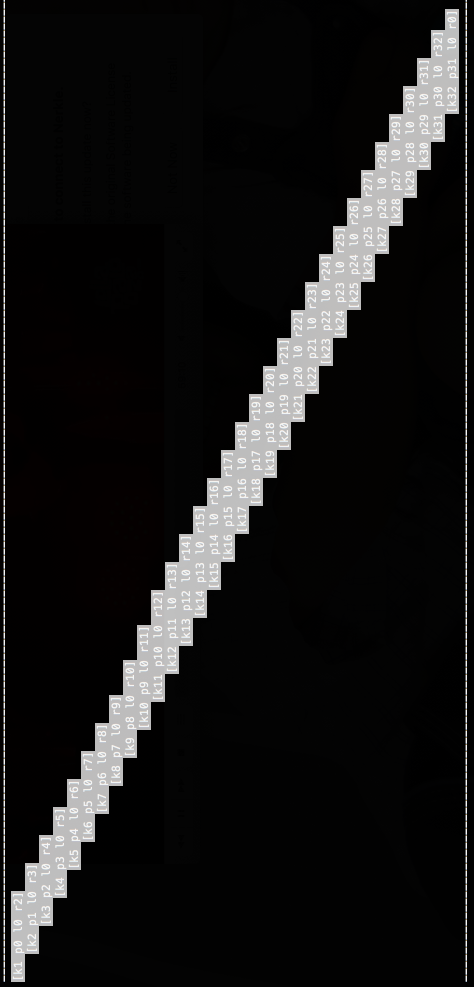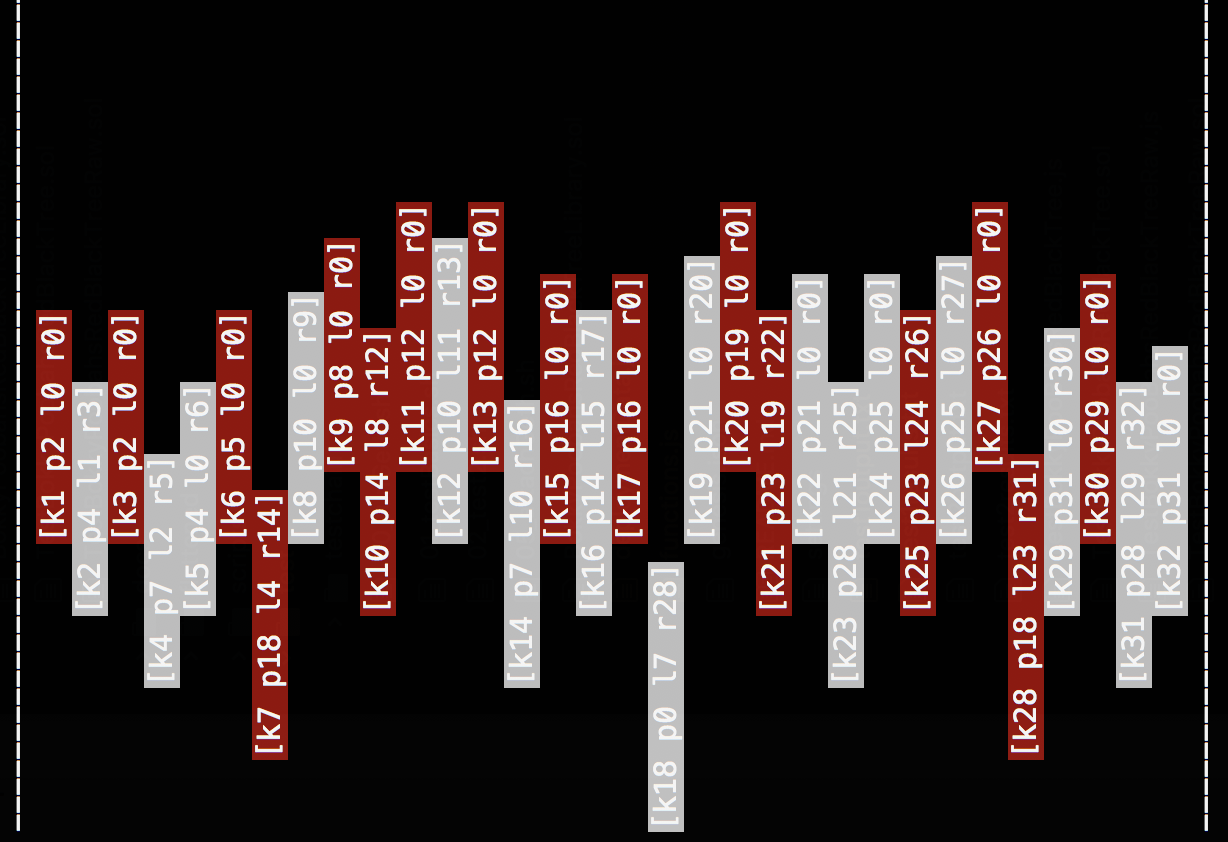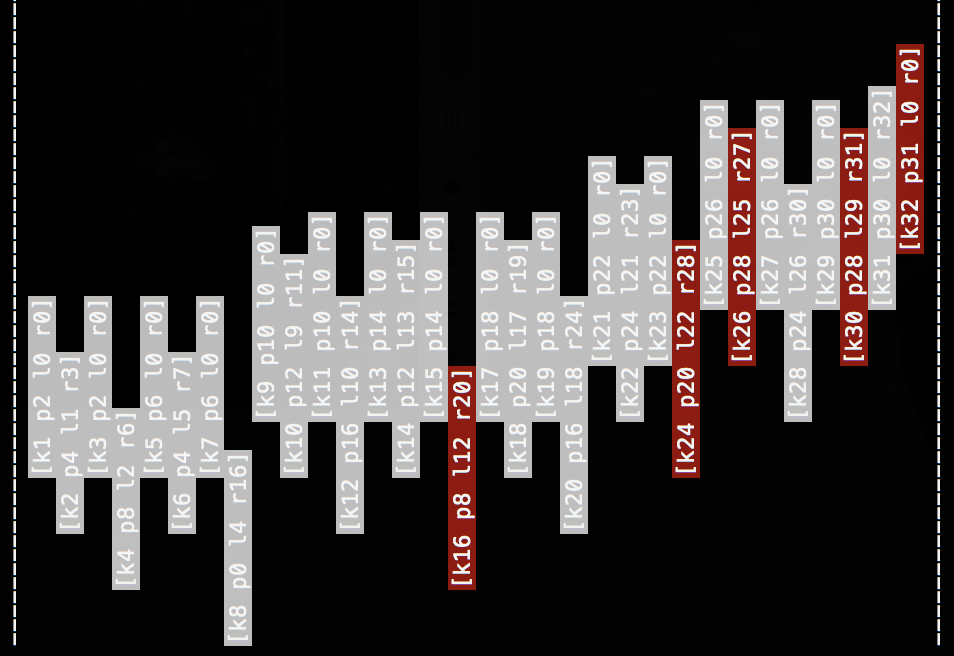Status: Work in progress. Documenting before getting further testing and review - don't use yet
A gas-efficient Solidity library using the iterative (rather than recursive) Red-Black binary search tree algorithm to help you maintain a sorted uint key index for your data. Insertions, deletions and searches are in O(log n) time (and ~gas). Note that the key of 0 is prohibited. Use the sorted keys as indices to your mapping tables of data to access your data in sorted order.
Inserting a key into an empty tree costs 68,459 gas. Inserting a key into a tree with 9,999 keys costs 127,210 gas on average. Removing an element from a tree with a single key costs 44,835 gas. Removing a key from a tree with 10,000 keys cost 81,486 gas on average.
An important use-case for this library is to maintain a sorted on-chain order book in decentralised exchange smart contracts, providing a provably fair order matching algorithm.
The Red-Black Tree binary search tree is a self-rebalancing binary search tree. Following is a diagram of a fairly well-balanced binary search tree.
The following unbalanced binary search tree was generated by inserting the numbers 1 to 32 in sequential order [1,2,3,4,5,6,7,8,9,10,11,12,13,14,15,16,17,18,19,20,21,22,23,24,25,26,27,28,29,30,31,32]:
Inserting the keys into the binary search tree in sequential order will result in this unbalanced tree resembling a linked-list.
The red-black algorithm maintains a red or black colouring for each node in the tree, and uses this information to maintain a reasonably balanced tree. From Wikipedia:
In addition to the requirements imposed on a binary search tree the following must be satisfied by a red–black tree:
- Each node is either red or black.
- The root is black. This rule is sometimes omitted. Since the root can always be changed from red to black, but not necessarily vice versa, this rule has little effect on analysis.
- All leaves (NIL) are black.
- If a node is red, then both its children are black.
- Every path from a given node to any of its descendant NIL nodes contains the same number of black nodes.
When an element is inserted into or removed from a red-black tree, the binary search tree is rebalanced to satisfy the red-black rules.
From Wikipedia's Red-Black Tree page, the following Red-Black tree was created by inserting the items [13,8,17,11,15,22,25,27,1,6]:
The following fairly well-balanced red-black tree was generated by inserting the numbers 1 to 32 in random order [15,14,20,3,7,10,11,16,18,2,4,5,8,19,1,9,12,6,17,13]:
The root node of the tree is 18, k represents the key numbers, p the parent, l the left node, r the right node. Nodes with l0 r0 are the leaves of the tree.
The following red-black tree was generated by inserting the numbers 1 to 32 in sequential order [1,2,3,4,5,6,7,8,9,10,11,12,13,14,15,16,17,18,19,20,21,22,23,24,25,26,27,28,29,30,31,32]:
A property of the red-black tree is that the path from the root to the farthest leaf is no more than twice as long as the path from the root to the nearest leaf. The shortest path has all black nodes and the longest path alternate between red and black nodes.
The shortest path is 4 levels deep: (8 black), (4 black), (2 black), (1 black).
The longest path is 8 levels deep: (8 black), (16 red), (20 black), (24 red), (28 black), (30 red), (31 black), (32 red). This is no more than twice as long as the shortest path.
The following table shows the minimum, average and maximum gas cost for the insertion of items in a random order and removal of items from a red-black tree:
| Items | Ins Min | Ins Avg | Ins Max | Rem Min | Rem Avg | Rem Max |
|---|---|---|---|---|---|---|
| 1 | 68,459 | 68,459 | 68,459 | 44,835 | 44,835 | 44,835 |
| 5 | 68,459 | 99,166 | 140,002 | 30,521 | 48,024 | 74,259 |
| 10 | 68,459 | 118,401 | 167,610 | 30,671 | 71,973 | 119,593 |
| 50 | 68,459 | 124,688 | 182,637 | 30,067 | 82,894 | 213,514 |
| 100 | 68,459 | 123,377 | 190,137 | 30,521 | 79,761 | 191,060 |
| 500 | 68,459 | 124,567 | 191,240 | 30,521 | 80,108 | 261,153 |
| 1,000 | 68,459 | 125,335 | 188,278 | 29,950 | 81,032 | 219,352 |
| 5,000 | 68,523 | 127,270 | 196,563 | 30,521 | 81,972 | 283,499 |
| 10,000 | 68,523 | 127,210 | 208,293 | 30,099 | 81,486 | 307,296 |
The following table shows the minimum, average and maximum gas cost for the insertion of items in a sequential order and removal of items from a red-black tree:
| Items | Ins Min | Ins Avg | Ins Max | Rem Min | Rem Avg | Rem Max |
|---|---|---|---|---|---|---|
| 1 | 68,459 | 68,459 | 68,459 | 44,835 | 44,835 | 44,835 |
| 5 | 68,459 | 107,349 | 140,753 | 29,918 | 56,072 | 86,075 |
| 10 | 68,459 | 116,513 | 149,588 | 30,067 | 75,757 | 119,064 |
| 50 | 68,459 | 137,949 | 158,598 | 30,067 | 86,002 | 213,537 |
| 100 | 68,459 | 142,907 | 163,103 | 30,521 | 87,266 | 218,371 |
| 500 | 68,459 | 149,290 | 191,089 | 30,521 | 86,200 | 266,556 |
| 1,000 | 68,459 | 150,802 | 208,341 | 29,950 | 87,266 | 287,889 |
| 5,000 | 68,459 | 153,263 | 242,846 | 30,521 | 88,336 | 310,295 |
| 10,000 | 68,459 | 154,113 | 260,099 | 29,950 | 88,003 | 333,443 |
If you find this library useful for your project, especially commercial projects, please donate to 0xb6dAC2C5A0222f6794265249ACE15568B750c2d1. I hope to cover my cost of getting this library independently audited.
This library has been designed to be automatically compiled into your Ethereum Solidity contract or library, instead of having to deploy this library and then linking your contract or library to this library.
See contracts/TestBokkyPooBahsRedBlackTree.sol (or the flattened version) for an example contract that uses this library.
Notes:
- The function parameter
Tree storage selfhas been omitted in the documentation below, as Solidity automatically injects the library data structure in place of this first parameter - There is a constant
SENTINELthat is set to 0 in the library source code by default
function init() internalCall this function from your contract constructor to initialises some data. Note that this is really only necessary when SENTINEL is non-0.
function root() internal view returns (uint _key);Returns the root of the tree, or SENTINEL is the tree is empty.
function inserted() internal view returns (uint _inserted);Number of keys inserted into the tree.
function removed() internal view returns (uint _removed);Number of keys removed from the tree.
function count() internal view returns (uint _count);Number of items in the tree.
function first() internal view returns (uint _key);Returns the smallest key in the tree.
| Return Value | Condition |
|---|---|
| {first key} | Tree has at least one key |
SENTINEL |
Tree empty |
function last() internal view returns (uint _key);Returns the largest key in the tree.
| Return Value | Condition |
|---|---|
| {last key} | Tree has at least one key |
SENTINEL |
Tree empty |
function next(uint x) internal view returns (uint y);Returns the next key in the tree with a value larger than x.
| Return Value | Condition |
|---|---|
| {next key} | There exists a key with a value larger than the x key |
SENTINEL |
Tree empty |
SENTINEL |
x is not an existing key in the tree |
SENTINEL |
x is the only key in the tree |
SENTINEL |
x is the last key in the tree |
function prev(uint x) internal view returns (uint y);Returns the previous key in the tree with a value smaller than x.
| Return Value | Condition |
|---|---|
| {prev key} | There exists a key with a value smaller than the x key |
SENTINEL |
Tree empty |
SENTINEL |
x is not an existing key in the tree |
SENTINEL |
x is the only element in the tree |
SENTINEL |
x is the last element in the tree |
function exists(uint key) internal view returns (bool _exists);Returns true if the key exists in the tree, false otherwise.
| Return Value | Condition |
|---|---|
| true | key is an existing key in the tree |
| false | Tree empty |
| false | key is not an existing key in the tree |
function getNode(uint key) internal view returns (uint _returnKey, uint _parent, uint _left, uint _right, bool _red);Returns the node information if key exists in the tree. All uint values will be set to SENTINEL if key does not exist in the tree.
function parent(uint key) internal view returns (uint _parent);Returns the parent of key.
| Return Value | Condition |
|---|---|
| {parent key} | key has a parent, when there are more than one item in the tree |
SENTINEL |
Tree is empty |
SENTINEL |
key is not an existing key in the tree |
SENTINEL |
key is the only element in the tree |
function grandparent(uint key) internal view returns (uint _grandparent);Returns the grandparent of key.
| Return Value | Condition |
|---|---|
| {grandparent key} | key has a parent that has a parent |
SENTINEL |
Tree is empty |
SENTINEL |
key is not an existing key in the tree |
SENTINEL |
key does not have a parent, or the parent does not have a parent |
function sibling(uint key) internal view returns (uint _sibling);Returns the sibling of key.
| Return Value | Condition |
|---|---|
| {sibling key} | key has a sibling |
SENTINEL |
Tree is empty |
SENTINEL |
key is not an existing key in the tree |
SENTINEL |
key does not have a sibling |
function uncle(uint key) internal view returns (uint _uncle);Returns the uncle of key.
| Return Value | Condition |
|---|---|
| {uncle key} | key has an uncle |
SENTINEL |
Tree is empty |
SENTINEL |
key is not an existing key in the tree |
SENTINEL |
key does not have an uncle |
function insert(uint z) internal;Insert the key z into the tree.
| Transaction | Condition |
|---|---|
| success | The key z has been successfully inserted into the tree |
| failure | The key z already exists in the tree |
function remove(uint z) internal;Remove the key z from the tree.
| Transaction | Condition |
|---|---|
| success | The key z has been successfully removed from the tree |
| failure | The key z does exist in the tree |
The main Red-Black binary search tree algorithm is listed in Algorithms for Red Black Tree Operations (from CLRS text).
Note that this algorithm is designed to work with memory pointers to the node data. The rebalancing process after the removal of an item from the tree may result in a swapping of data values between nodes.
As the nodes are stored as elements in a Solidity mapping data structure, Iterative Algorithm for Red-Black Tree provides an alternative algorithm to perform this swapping. In particular, the function RB-Delete in the main Red-Black algorithm will need the line then key[z] := key[y] replaced with the alternative swapping algorithm.
- Test random insertions and deletions of 1, 10, 100, 1000 and 10000 keys
- Test the insert function, including inserting a duplicate key
- Test the
removefunction, including removing a non-existent key - Test the
viewfunctions, including what happens when a non-existent key is passed - Test sequential insertions
- Test repeated random insertions and deletions
- Red–black tree - Wikipedia
- Algorithms for Red Black Tree Operations - from Introduction to Algorithms by Cormen, Leiserson, Rivest and Stein.
- Iterative Algorithm for Red-Black Tree
- Laboratory Module 6 - Red-Black Trees - Mihail Buricea. A copy has been saved to docs/lab8ASD.pdf
- https://www.cs.dartmouth.edu/~thc/cs10/lectures/0519/0519.html
- https://www.csee.umbc.edu/courses/undergraduate/341/fall13/section3/lectures/10-Red-Black-Trees.pdf
- http://cseweb.ucsd.edu/~kube/cls/100/Lectures/lec7/lec7.pdf
- https://www.geeksforgeeks.org/red-black-tree-set-1-introduction-2/
Thanks to James Zaki and Solidified for the 3 minor issues they picked up at the Web3 Summit.
Enjoy!
(c) BokkyPooBah / Bok Consulting Pty Ltd - Nov 03 2018. The MIT Licence.


